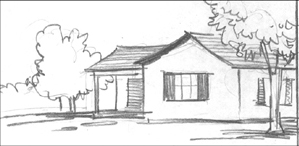A native of southern California, Michael Obermeyer received a Bachelor of Fine Arts degree in Illustration at California State University, Long Beach. Some of his paintings are featured in collections in the Smithsonian Institute and the Pentagon in Washington, D.C. He recently received the “Award of Excellence” from the La Quinta Desert Plein Air show and the Gold Medal at the Carmel Art Studio. Michael is a member of the Oil Painters of America, The California Art Club, The American Impressionist Society, The Society of Illustrators. and a Signature Member of the Laguna Plein Air Painters’ Association. Currently Michael’s paintings are shown at galleries in Carmel and Laguna Beach, California, where he also maintains his studio.
FALL LANDSCAPE
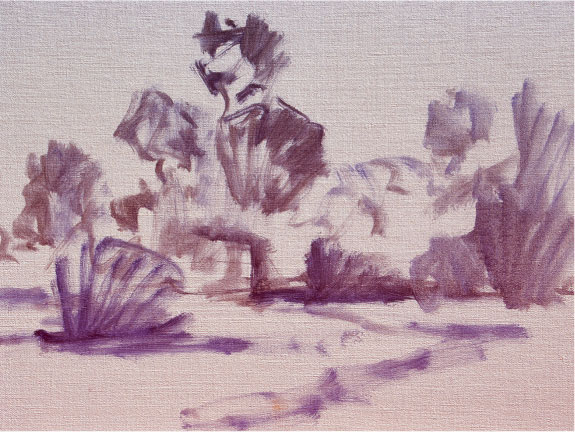
STEP ONE
Using a light wash of ultramarine blue, I draw the scene on the support with a small brush, using my field sketch as a reference. I’m not concerned with details at this point—this is just a quick layout to outline the major elements. I also indicate the visual path (in this case, a literal path) that will lead the eye toward my focal point (the large trees on the left).

STEP TWO
Using flat sable brushes, I block in the basic shapes of the darkest trees, starting with the warm, intense colors and values in the foreground. I use a mix of viridian green, cadmium red light, and ultramarine blue, keeping the darkest values in the trees so that the contrasting warm colors around the trees will appear to “pop” forward.

STEP THREE
Now I begin blocking in the sunlit trees with a mixture of alizarin crimson, cadmium yellow deep, ultramarine blue, and cadmium yellow light. I use large flats and brights alternately, painting quickly with thick paint and bold brushstrokes. Then, using medium-sized flats, I paint in the pathway and the variety of dark and light areas on the grass in the foreground with mixes of ultramarine blue and cadmium yellow light.
Trees

Alizarin crimson, cadmium yellow deep, cadmium yellow light, and ultramarine blue
STEP FOUR
With a large flat brush, I paint in the sky with a mixture of cerulean blue, cadmium yellow light, viridian green, and a lot of titanium white. I combine ultramarine blue, alizarin crimson, and white to dab in the dark areas of the low clouds. For the sunlit areas of the clouds, I use a mix of cadmium yellow light, alizarin crimson, and white, painting right up to the edges of the trees.
Sky

Cadmium yellow light, viridian green, cerulean blue, and white

STEP FIVE
Now I add details to the trees with a small flat brush, softening the edges as I work. I use the colors from step three and work all over the trees, never spending too much time in one area. Then I add the tree trunks and the finer details in the foreground grass with a rigger brush. This brushwork is tighter and the edges are sharper than those in the background, which helps bring attention to my focal point.

STEP SIX
Finally I step back and take a look at my work. I check to see whether any of the values need adjustment and decide to add some colorful flowers in the foreground to anchor the viewer’s eye at the left of my composition, where the focal point is located. With a rigger brush and a mix of cadmium yellow light and white, I lightly dab in the blossoms, taking care to keep them in proportion with the rest of the elements in the landscape. I step back to assess the painting and decide that now I’m happy. The most difficult part is knowing when the painting is finished and putting the brush down!
DESERT CASITA

STEP ONE
I use a light wash of ultramarine blue to loosely draw my composition on the canvas. I keep the paint thin so I can easily rework or adjust the sketch if necessary. Then I use a large flat sable brush and bold, quick brushstrokes to block in the darkest areas with a thin mix of ultramarine blue, alizarin crimson, and a touch of viridian green.

STEP TWO
Next I block in the rest of the basic shapes, working from the warm tones in the front to the cool tones in the back. I paint the tree trunk with a mix of cadmium yellow light, cadmium red light, and white. I use a large filbert and block in the trees and grass with mixes of ultramarine blue and cadmium yellow deep. Then I mix in some viridian green and cadmium yellow light for the cooler areas, keeping the shapes simple.
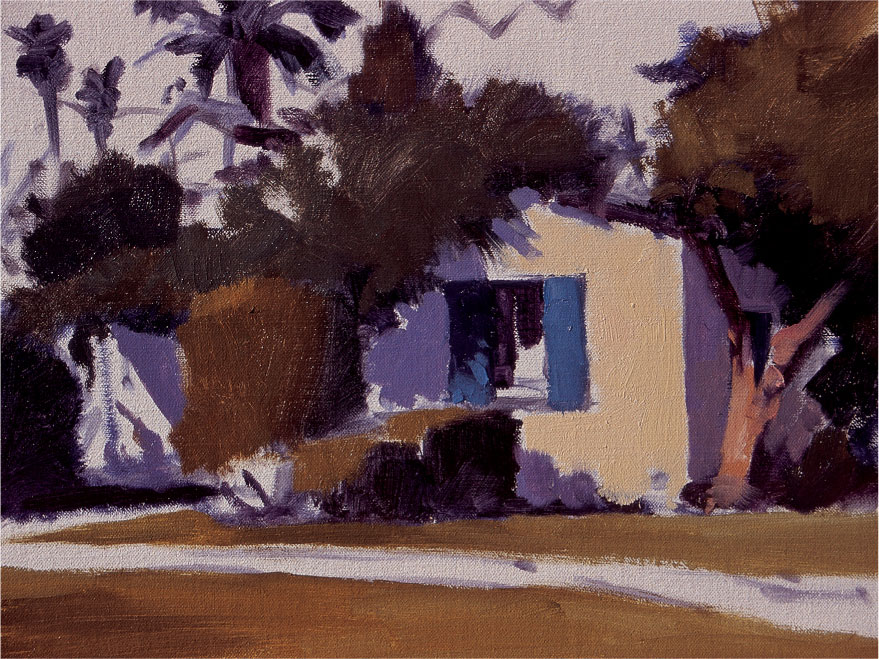
STEP THREE
Now I paint the stucco with a thick mix of white and specks of cadmium yellow light, cadmium yellow deep, and alizarin crimson. Using a small flat brush, I dab in the shutters with a mixture of cerulean blue and a little ultramarine blue. I create the shadows on the side of the house with a mix of ultramarine blue, alizarin crimson, and white.
Stucco
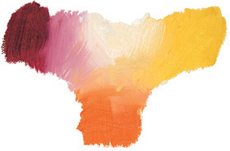
Alizarin crimson, white, cadmium yellow light, and cadmium yellow deep
House Shadows

Ultramarine blue, alizarin crimson, and white
STEP FOUR
Now I begin to work all over the painting with a small flat brush, building up thick highlights and adding a variety of brushstrokes for interest. I refine the shadows on the house with a small filbert, keeping the edges soft. Then I paint the mountains in the background with a mix of white, alizarin crimson, cadmium yellow deep, and a touch of ultramarine blue, adding more ultramarine blue and a touch of alizarin crimson for the shadows. I paint the roof with small flat brushes and a mix of cadmium yellow light, cadmium red light, cadmium yellow deep, and a touch of ultramarine blue. I also paint in pure alizarin crimson for the base color of the flowers.
Flowers

Ultramarine blue, cadmium red light, alizarin crimson, and white

STEP FIVE
For the shadowed flowers, I add ultramarine blue to alizarin crimson. I paint highlights and details in the flowers using alizarin crimson and cadmium red light with a touch of white, dabbing the paint on with small flats and brights. I move around the painting, adding details to the mountain, tree trunk, plants, mountain, and shadows. Next I apply highlights to the shrubs with a mix of the original color plus more cadmium yellow light. I paint more details on the palm trees, keeping their edges softer than those of the foliage in the foreground. Finally I add details on the windowpanes with a small brush and a mix of cerulean blue and a small amount of ultramarine blue.
CENTRAL PARK
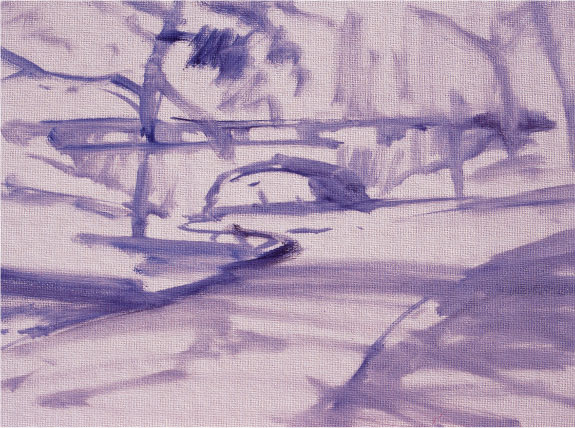
STEP ONE
I quickly sketch in my composition with a thin wash of ultramarine blue, taking no more than five minutes to place the basic shapes. As I sketch, I keep in mind how the strong shadows will affect the other elements in my composition; I want the shadows to be my focal point.

STEP TWO
With a thin mix of ultramarine blue and cadmium yellow light, I block in the shadows on the grass with quick, bold brushstrokes. I place the tree trunks and the bridge with a mix of alizarin crimson and ultramarine blue. Then I use a large flat to work in the cool shadows on the road and trees, keeping the edges soft and the shapes simple.
Shadowed Street

Ultramarine blue, alizarin crimson, and white

STEP THREE
Now I add the warmest tones: the sunlit grass in the foreground and the light areas of the tree in front. I keep the paint thick, using strong, bold brushstrokes and not worrying about detail at this point. For the grass, I use a mix of cadmium yellow light with a touch of viridian green and a speck of cadmium yellow deep.
STEP FOUR
I develop the sunlit areas of the street with a mix of cadmium yellow light, alizarin crimson, white, and a touch of cadmium yellow deep. I add the sky (cerulean blue, white, and cadmium yellow light) and the distant trees (alizarin crimson, ultramarine blue, and white). Then I block in the distant buildings with a mix of ultramarine blue and white.
Sunlit Street

Alizarin crimson, cadmium yellow deep, and cadmium yellow light

STEP FIVE
With small flats, I work throughout the entire painting, adjusting values as necessary and adding branches and a bit more detail to the trees in the foreground. With the same small brushes, I continue developing details on the bridge, the curbs, and the flowers. I include a little more detail on and under the arch of the bridge, keeping the edges sharp to draw some attention there. I place the signpost and refine the tree trunks, but I try not to overwork any one area of the painting and avoid putting in too much detail. I step back to assess my work again and decide that the contrast between the sunlit patches and the cool shadows is well balanced; my painting is done!







